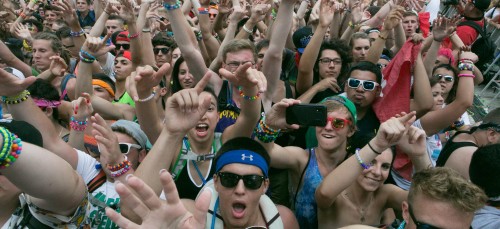
Many critics in the past several months have come out criticizing the popular EDM proliferating a sexist culture.
“Skrillex keeps putting butts in my Twitter feed,” Pitchfork critic Philip Sherburne wrote, referring to a promotional photograph of a woman scantily clad in tight, fuchsia bikini bottoms with a prominent thigh gap. In lieu of a face, the body was topped with a skull.
Using such a sexually charged image as a marketing tool for the music label’s new album and show is just one example, Sherburne said, of the widespread objectification of women and “it seems like it is getting worse.”
But Sherburne is not the only one critical.
“(The) girl who is so sure she’s not a dehumanized sexual caricature, but still shows up naked to shake her (butt) upside down and put stickers on her (breasts) … because ‘it’s the culture,’” Kat Bien, a writer for the Miami New Times said. “Much like a Dali painting, if we step back far enough and look at the whole picture, this takes on a totally different meaning.”
Further criticism is rooted in the belief that EDM is part of a wild and crazed drug culture, which some say leads to its stigmatization stemming from rave culture of the ’80s and ’90s.
Some die-hard fans are quick to disagree with this characterization. Alex, a DePaul student who asked to withhold her last name, somewhat denied the accusation. In her experience, the culture largely still emphasizes “PLUR,” (Peace, Love, Unity, Respect) and objectifying women would breach that contract.
“We generally dress in what most of the population would call ‘slutty’ clothes, but it just gets really hot in there and everyone is dancing like crazy,” she said. “Considering that I am wearing minimal clothing, it’s clear to pick out which guys are ravers or not. Raver guys will politely ask you to dance and always give you a hug no matter if you say yes or no.”
Still, she said some men do cross the line, but those who are familiar with the scene understand the boundaries.
“Partially, it is due to MDMA (Ecstasy) and partially because of the vibes,” she said. “There are guys, who are closed minded and on the prowl. (They) are generally grabbing girls when they walk by.”
DePaul sophomore Ellen Golackson described the scene as “very respectful.”
“Yes, everyone else was wearing furry leg warmers and on acid but as a female I never once felt objectified,” she said.
There’s also criticism of other genres to consider: there are few female-led bands slotted for festivals, and other artists have been vocal about their own objectification.
“There is probably as much sexism in rock music as there is in the rest of the society in which music is appreciated,” DePaul sociology professor and rock expert Deena Weinstein said.
Student Roy Curiale also reflected on the EDM scene.
“I like EDM, but I worry sometimes that it has become too objectifying to women,” he said. “It’s all sex it seems. But that’s what sells. Besides, is this sexist culture any different from the sexist culture of the music industry in general?

